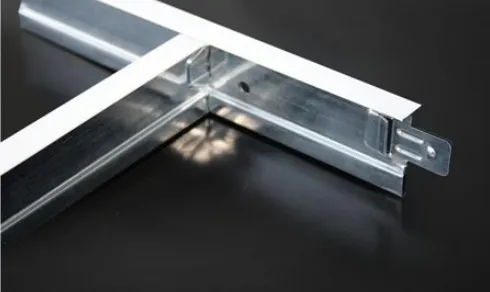Nov . 27, 2024 09:29 Back to list
Suspended Ceiling Tile Systems and Grid Installation Techniques for Modern Spaces
Suspended Ceiling Grid and Tiles An Overview
Suspended ceiling systems, often referred to as drop ceilings or false ceilings, are widely used in modern construction and interior design. They offer not only aesthetic appeal but also practical benefits in terms of acoustic control, insulation, and easy access to building services such as wiring and plumbing. Understanding the components of a suspended ceiling, particularly the grid and tiles, is vital for architects, builders, and homeowners alike.
What is a Suspended Ceiling?
A suspended ceiling is installed beneath the main structure of a building, creating a gap between the original ceiling and the new installation. This space serves various purposes, including the concealment of electrical wiring, plumbing, and HVAC systems. The ceiling is made up of a grid system that holds lightweight tiles, which can be easily removed for maintenance purposes.
The Ceiling Grid
The grid system is the skeletal framework that supports the ceiling tiles. Made from materials such as metal, aluminum, and sometimes PVC, the grid comprises a series of main beams and cross tees, which create a network of squares or rectangles.
One of the key considerations in designing a suspended ceiling grid is the spacing and height. Generally, the main beams are placed at intervals of either 4 or 5 feet, with cross tees fitting into them to create the desired tile layout. A properly installed grid must be level and securely fastened to the existing ceiling structure, ensuring that it can adequately support the weight of the tiles.
Types of Ceiling Tiles
Suspended ceiling tiles come in a variety of materials, sizes, colors, and finishes. Common materials include mineral fiber, fiberglass, metal, and PVC. Each type of tile offers distinct benefits
1. Mineral Fiber Tiles The most commonly used material for acoustic control, mineral fiber tiles are lightweight, sound-absorbent, and can be painted or left in their natural state. 2. Fiberglass Tiles Known for their excellent thermal insulation properties, fiberglass tiles are also resistant to moisture and mold, making them ideal for high-humidity areas such as bathrooms and kitchens.
suspended ceiling grid and tiles

3. Metal Tiles Often chosen for aesthetic purposes, metal tiles can offer a sleek, modern look. They are durable and can enhance acoustics when designed properly.
4. PVC Tiles These are highly versatile and available in numerous designs, including patterns that mimic wood, stone, or elegant textures. They are also resistant to moisture, making them ideal for areas with high humidity.
Installation and Maintenance
Installing a suspended ceiling grid and tiles is a task best performed by professionals, though experienced DIY enthusiasts may tackle simpler projects. The process begins with the measurement of the room and determining the layout of the grid. Once the grid is in place, the tiles can be easily laid into the grid openings.
Maintenance is straightforward; individual tiles can be replaced without disturbing the entire system. If a tile becomes stained or damaged, simply removing it and replacing it with a new one can restore the ceiling’s appearance. Regular cleaning can prevent dust and grime build-up, thus prolonging the lifespan of the tiles and maintaining a pleasant aesthetic.
Benefits of Suspended Ceilings
The advantages of suspended ceiling systems are numerous. They improve acoustics by reducing noise levels in both commercial and residential spaces. Furthermore, they can contribute to energy efficiency by providing insulation, helping to reduce heating and cooling costs.
Moreover, the ability to access hidden services is a significant benefit. In case of repairs or modifications to electrical and plumbing systems, the grid allows for easy access without major renovations.
Conclusion
In summary, suspended ceiling grid and tiles provide a practical, attractive solution for modern interior spaces. They enhance the aesthetics of a room, improve sound management, and offer easy access to building utilities. When planning an installation, it is important to consider the type of tiles, the layout of the grid, and the specific needs of the space. Whether in an office, school, or home, suspended ceilings can significantly contribute to the overall functionality and appeal of the environment.
-
Durable Ceiling T Grid Systems | Easy InstallationNewsAug.29,2025
-
PVC Gypsum Ceiling: Durable, Laminated Tiles for Modern SpacesNewsAug.28,2025
-
Pvc Gypsum Ceiling Is DurableNewsAug.21,2025
-
Mineral Fiber Board Is DurableNewsAug.21,2025
-
Ceiling Tile Clip Reusable DesignNewsAug.21,2025
-
Ceiling T Grid Modular DesignNewsAug.21,2025







